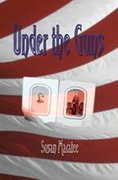Sarah Emma EdmondsSarah Emma Edmonds was born in New Brunswick, Canada in 1841. She grew up on a farm, so along with her sisters, she participated beside her one brother to perform the hard physical work of farming. She tended to the animals, chopped wood, milked cows, planted and harvested. She also learned to ride horses, hunted and fished.
Her upbringing caused her to develop a lean, masculine-looking physique.
In 1860 she was nineteen. She moved south into the United States dressed in men's garb. Pretending to be a man, she called herself "Franklin Thompson". She worked in Hartford, Connecticut as a publishing agent, selling Bibles in Canada and Michigan.
In 1861 the Civil War began. She enlisted in Company F of the 2nd Michigan Infantry Volunteers, signing up for three years.
As
Franklin Thompson, Sarah spent her first months of military service at the regimental hospital, serving as a "male" nurse. She then became postmaster and then a mail carrier.
One of her superior officers, General O. M. Poe, recalled that "Frank Thompson was effeminate looking, and for that reason was detailed as a mail carrier, to avoid taking an efficient soldier from the ranks."
All the Daring of the Soldier: Women of the Civil War Armies, p. 171.
As a mail carrier, Edmonds carried two or three bushels of mail over a distance of 50 or 60 miles.
In her own words: "I was often compelled to spend the night alone by the roadside. It was reported that the bushwackers had murdered a mail carrier on that road and robbed the mail, and there seemed to be evidence of the fact, for, in the most lonely spot of all the road the ground was still strewn with fragments of letters and papers, over which I often passed when it was so dark that I only knew it by the rustle of the letters under my horse's feet."
All the Daring of the Soldier: Women of the Civil War Armies, pp. 171-172.
She was also engaged in combat starting with the battle of First Bull Run in July 1861.
According to a Congressional report: "Franklin Thompson, gave his heart and soul to the regiment, sharing in all its toil and privations, marching and fighting in the various engagements in which it participated . . . (He was) never absent from duty, obeying all orders with intelligence and alacrity, his whole aim and desire to render zealous and efficient aid to the Union cause."
All the Daring of the Soldier: Women of the Civil War Armies, pp. 172-173.
While serving, Sarah became good friends with a young medical steward and assistant surgeon for the 2nd Michigan. She fell in love with the man, confessing to him that she was female. She felt rebuffed when he told her he was betrothed.
Besides soldiering, Sarah also served the Union as a spy. She disguised herself as a a male fugitive slave, wearing a wig and coloring her skin with silver nitrate.
http://civilwar.bluegrass.net/SpiesRaidersAndPartisans/sarahemmaedmonds.html/ At other times she portrayed a female Irish peddler by the name of Bridget O'Shea.
http://en.wikipedia.org/wiki/Sarah_Edmonds/In Kentucky in the Spring of 1863, Sarah fell ill with chills and fever. She feared a hospital stay would expose her sex, so, after a request for a leave of absence was denied, she deserted the army. She checked herself into a civilian hospital, planning to return to the army once she'd recovered.
On learning that Franklin Thompson was wanted for desertion, she donned women's clothes, resumed using her real name and returned to the army to serve as a female nurse for the remainder of the war.
All the Daring of the Soldier: Women of the Civil War Armies, p. 178
After the war ended, she published her autobiography,
Nurse and Spy in the Union Army under the pen name of S. E. Edmonds. "In 1867, she married L. H. Seelye, a Canadian carpenter with whom she had three children."
http://en.wikipedia.org/wiki/Sarah_Edmonds/Beginning in 1886, she was given a government pension of $12 a month. She died in LaPorte, Texas and is buried in Houston, Texas. "She was inducted into the Michigan Women's Hall of Fame in 1992."
http://en.wikipedia.org/wiki/Sarah_Edmonds/For more on Sarah Emma Edmonds:
Sources:
All the Daring of the Soldier: Women of the Civil War Armies by Elizabeth D. Leonard, pp. 170-185.
http://civilwar.bluegrass.net/SpiesRaidersAndPartisans/sarahemmaedmonds.html/
http://mariah.stonemarche.org/livhis/women/edmonds.htm/http://en.wikipedia.org/wiki/Sarah_Edmondshttp://womenshistory.about.com/library/bio/blbio_sarah_emma_edmonds.htm/ In "Women In the Ranks - Part II", I'll be talking about another woman Union soldier, Jennie Hodgers.













